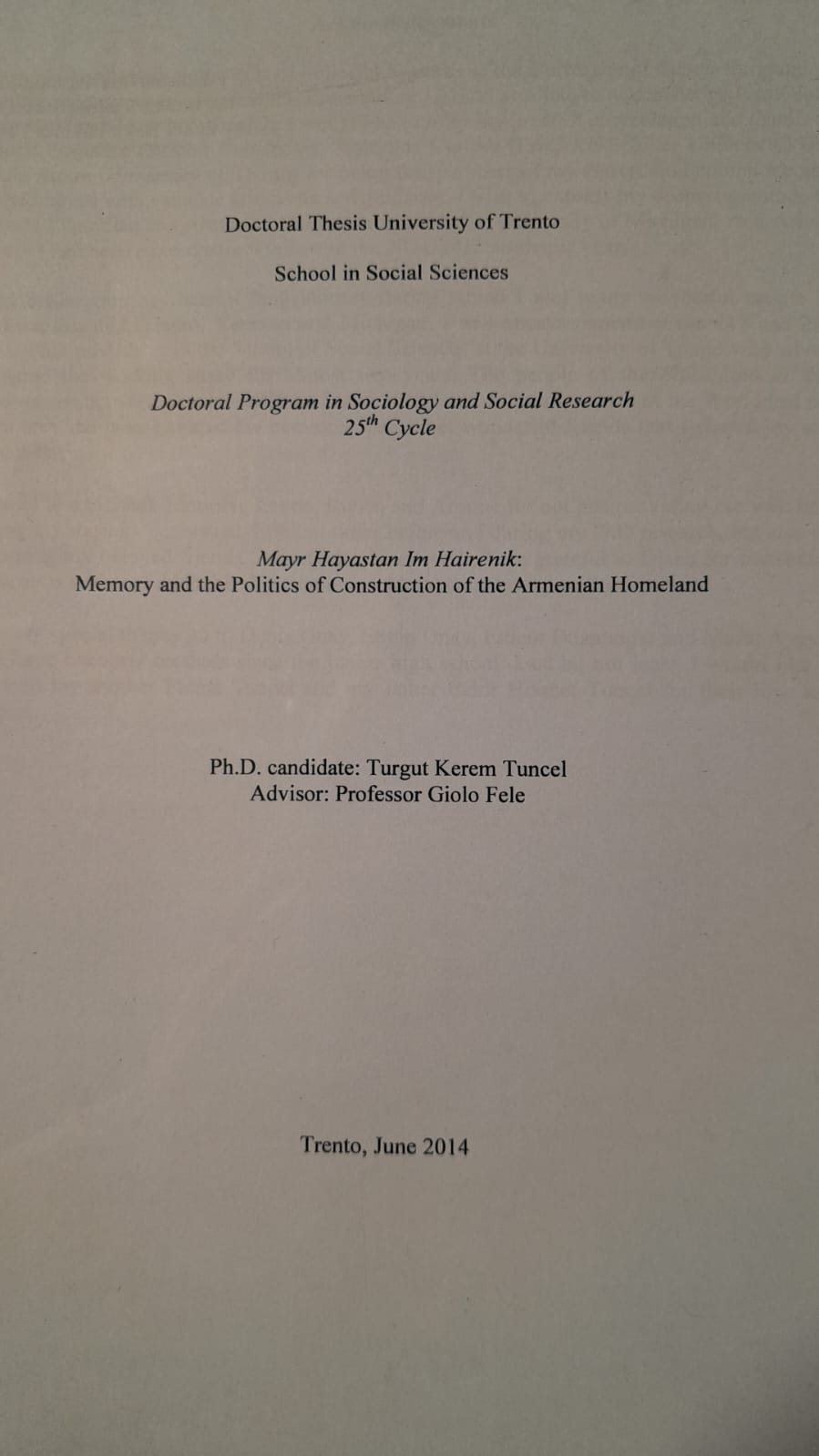
| Материал | : | Tez |
| IЫхьэ | : | Siyaset, Tarih, |
| Тхыгъэм и ЦIэр | : | Mayr Hayastan Im Hairenik: Memory and the Politics of Construction of the Armenian Homeland |
| ТхакIуэ | : | Turgut Kerem Tuncel, |
| Щытырадзар | : | Trento |
| ТедзапIэ | : | |
| Щытырадза Зэман | : | 2014 |
| Волумэ Номыр | : | |
| НапэкIуэцI бжыгъэ | : | 426 |
| ISBN Номыр | : | |
| Бзэ | : | İngilizce |
| ТелъхьэпIэ Номыр | : | ENG.KT.00233 |
| Зытеухуар | : | |
| Даущ | : | Establishment of the independent Republic of Armenia in 1991 has been a turning point in the Armenian history; except for the existence of an independent Armenian republic between 1918 and 1920, by the dissolution of the USSR, Armenians gained an independent state after more than six hundred years. The transition of the Soviet Armenia to an independent republic stimulated not only the radical dislocation of the established economic, political and socio-cultural structures in Armenia, but also transformed the routine in the Armenian diaspora communities. In this process, aiding the frail and infant independent Armenian republic became a paramount ethno-national cause among the diaspora communities and, by extension, one of the principal ethno-national binders, as well as a chief cause of controversies. Overall, the post-1991 era has witnessed the re-territorialization of the de-territorialized Armenian political imagination in the diaspora. This facilitated the post-1991 trans-state Armenian ethno-national re-construction along the Armenia-diaspora nexus. A parallel process to that has been the construction of the social reality of the post-1991 Armenia. This dissertation examines the construction of the Armenian ethno-national social reality of the post-1991 Armenia through the discursive social practices of the Armenian state, new generation diaspora organizations and the diasporic individuals within the communicative space formed along the Armenia-diaspora nexus. The examination demonstrates that concerns over the physical and cultural survival of the Armenian ethno-nation expressed in different ways are the main considerations that eventually result in the construction of the post-1991 Armenia as the guardian and the soil of the Armenianness. From an abstract point of view, the actual agent of discourses that speaks through the Armenian state, new generation diaspora organizations and the diasporic individuals is the “anxious Armenian” who searches stability and security, reclaims her ethno-national identity, and is concerned about the cultural survival of the Armenian ethno-nation. Besides all, she is the one who “remembers” the genocide. This “anxious Armenian”, instead, is the person that the social memory of the genocide speaks itself through. As such, genocide is not only the “defining and founding moment” of the contemporary Armenian identity, but also the “defining and founding moment” of the post-1991 Armenia. |
| Псалъэ Нэхъыщхьэхэр | : | Ermenistan, , |
| Материал | : | Tez |
| IЫхьэ | : | Siyaset, Tarih, |
| Тхыгъэм и ЦIэр | : | Mayr Hayastan Im Hairenik: Memory and the Politics of Construction of the Armenian Homeland |
| ТхакIуэ | : | Turgut Kerem Tuncel, |
| Щытырадзар | : | Trento |
| ТедзапIэ | : | |
| Щытырадза Зэман | : | 2014 |
| Волумэ Номыр | : | |
| НапэкIуэцI бжыгъэ | : | 426 |
| ISBN Номыр | : | |
| Бзэ | : | İngilizce |
| ТелъхьэпIэ Номыр | : | ENG.KT.00233 |
| Зытеухуар | : | |
| Даущ | : | Establishment of the independent Republic of Armenia in 1991 has been a turning point in the Armenian history; except for the existence of an independent Armenian republic between 1918 and 1920, by the dissolution of the USSR, Armenians gained an independent state after more than six hundred years. The transition of the Soviet Armenia to an independent republic stimulated not only the radical dislocation of the established economic, political and socio-cultural structures in Armenia, but also transformed the routine in the Armenian diaspora communities. In this process, aiding the frail and infant independent Armenian republic became a paramount ethno-national cause among the diaspora communities and, by extension, one of the principal ethno-national binders, as well as a chief cause of controversies. Overall, the post-1991 era has witnessed the re-territorialization of the de-territorialized Armenian political imagination in the diaspora. This facilitated the post-1991 trans-state Armenian ethno-national re-construction along the Armenia-diaspora nexus. A parallel process to that has been the construction of the social reality of the post-1991 Armenia. This dissertation examines the construction of the Armenian ethno-national social reality of the post-1991 Armenia through the discursive social practices of the Armenian state, new generation diaspora organizations and the diasporic individuals within the communicative space formed along the Armenia-diaspora nexus. The examination demonstrates that concerns over the physical and cultural survival of the Armenian ethno-nation expressed in different ways are the main considerations that eventually result in the construction of the post-1991 Armenia as the guardian and the soil of the Armenianness. From an abstract point of view, the actual agent of discourses that speaks through the Armenian state, new generation diaspora organizations and the diasporic individuals is the “anxious Armenian” who searches stability and security, reclaims her ethno-national identity, and is concerned about the cultural survival of the Armenian ethno-nation. Besides all, she is the one who “remembers” the genocide. This “anxious Armenian”, instead, is the person that the social memory of the genocide speaks itself through. As such, genocide is not only the “defining and founding moment” of the contemporary Armenian identity, but also the “defining and founding moment” of the post-1991 Armenia. |
| Псалъэ Нэхъыщхьэхэр | : | Ermenistan, , |